Published Sep 7, 2014
Six Strange Star Trek Covers
Six Strange Star Trek Covers
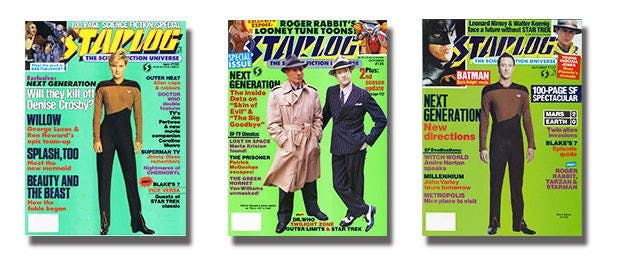
Let’s play publisher! It’s April 1988—and Starlog #130 -- spotlighting Denise Crosby as Tasha Yar -- hits the newsstands. It’s a bestseller for the company. And now, the question is… Why?
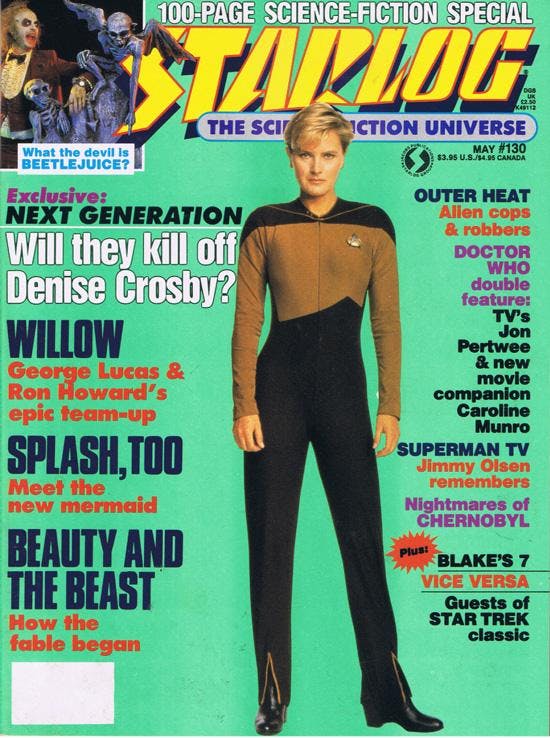
Play along with me as we reveal the colorful backstory. I had been the magazine’s Editor for three years then and chose that Crosby shot (an image subject, natch, to veto or approval by Publisher Norman Jacobs). At the time, three separate sets of coverlines were written for an issue, one each from my two Managing Editors (Eddie Berganza, Dan Dickholtz) and me. A lively "coverline meeting" with Assistant Publisher Milburn Smith narrowed those three choices via debate, generating one stronger, combined set. Those finalists were subjected to a later "cover meeting" of the four of us with Jacobs (who had the last say and might alter anything). Anyhow, that’s all done. The issue’s printed and it sold well. To repeat, why? Here are possible reasons:
1) The allure of Denise Crosby (the full head-to-toe photo alone).
2) Crosby discussing her potential departure from Star Trek: The Next Generation in an exclusive interview with Marc Shapiro.
3) That provocative coverline "Next Generation: Will they kill off Denise Crosby?"
4) Timing! The issue accidentally appeared at the height of Crosby exit interest.
5) The fluorescent green background.If you were the Editor (like me) dissecting that issue post-publication, it’s simply obvious why it sold: Must be a blend of reasons 1-4. But be a publisher, and the answer is somehow different: Got it? Yes, the color green.
Well, I disagreed with that assessment (natch!). But the "fifth hit" ink had been a publisher decision, involving extra cost (not only for the "hot green" ink, but the required extra presstime). Maybe that’s why Jacobs believed the sales increase was due to the shade. After all, he had spent the additional greenbacks and had thus been solely responsible for going green.
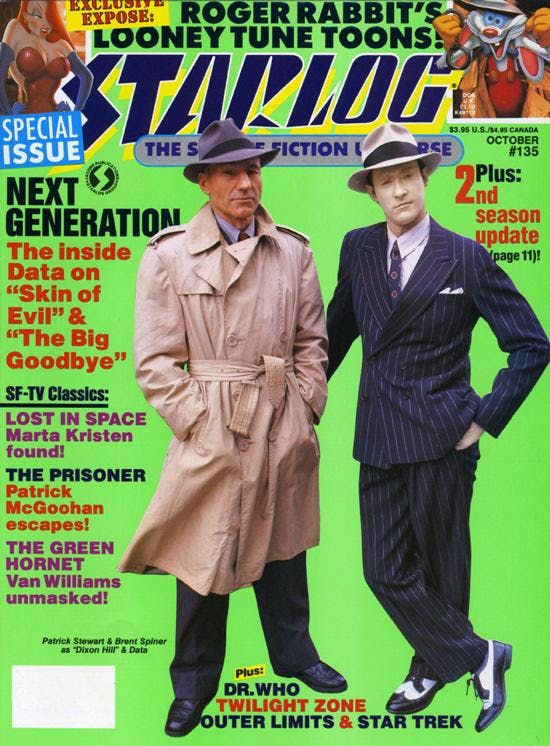
During its initial run, Star Trek: The Next Generation was Starlog’s default cover choice whenever something else fell through. Brief example: 20th Century Fox won’t give us a pre-release photo of Edward Scissorhands for issue #162’s cover out in December 1990? Sayonara, Scissorhands! We have a LeVar Burton interview on hand. Let’s do a Burton as Geordi La Forge cover instead! That’s also true of #135 and #147. I no longer recall what their other cover contenders were, but we went with Patrick Stewart as Dixon Hill and Brent Spiner as Data (#135) and then Spiner solo (#147). And did you notice the background color? Yes, green! That’s intentional, a naked, cold-blooded attempt to duplicate #130’s sales: Next Gen actors, full-body shots, green backgrounds.
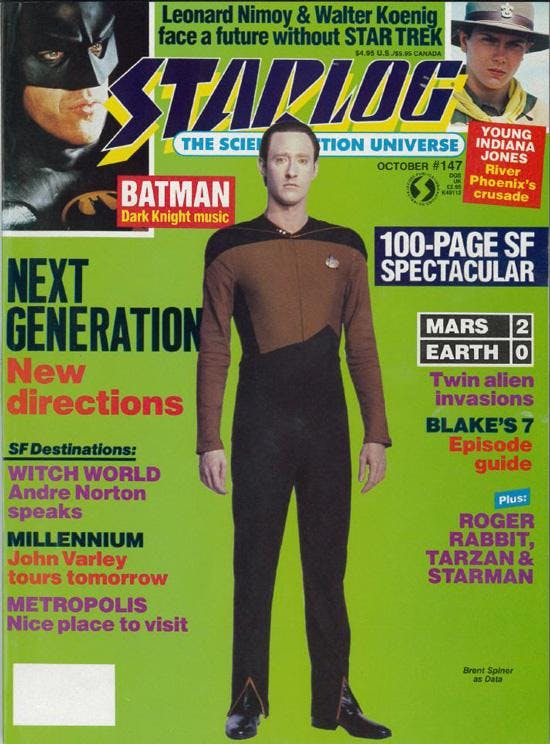
That’s how cover folklore works in publishing. One cover with risky, distinctive elements sells, so let’s do more just like it! At DC Comics, in the late 1950s and early ’60s, my pal the legendary editor Julius Schwartz and his colleagues discovered that when they inadvertently included an ape on a comic cover, sales spiked. Hence, more cover monkeys and guest gorillas to bedevil the Flash, Superman and friends. At Marvel Comics in the 1970s, my friend writer-editor Roy Thomas found that having a skeleton somewhere on a Conan the Barbarian cover similarly sparked sales. More cover skullduggery ensued. Amusing, eh? Ironically, before Starlog #130, a Jacobs-imposed, superstitious company rule had been that "Green never sells!" so the color was avoided like the plague—until Tasha Yar made it fashionable.
Now, for a few more Strange Starlog Cover Stories...
Starlog began life as a one-shot publication about all things Trek in June 1976. At first, the plan was to entitle it Star Trek, but lawyers iced that studio-owned trademark. Likewise, the contents were expanded before it was published to include non-Trek topics to avoid litigation. I wasn’t around then (still in college), so I’m uncertain who came up with the alternate title, Starlog: Publisher Kerry O’Quinn? Publisher Jacobs? Before teaming up, both got into the magazine business in the 1960s as art directors, so the visuals were always their greater concern. I do know O’Quinn designed the magazine’s logo, which remained in use (with modifications) for 32 years.
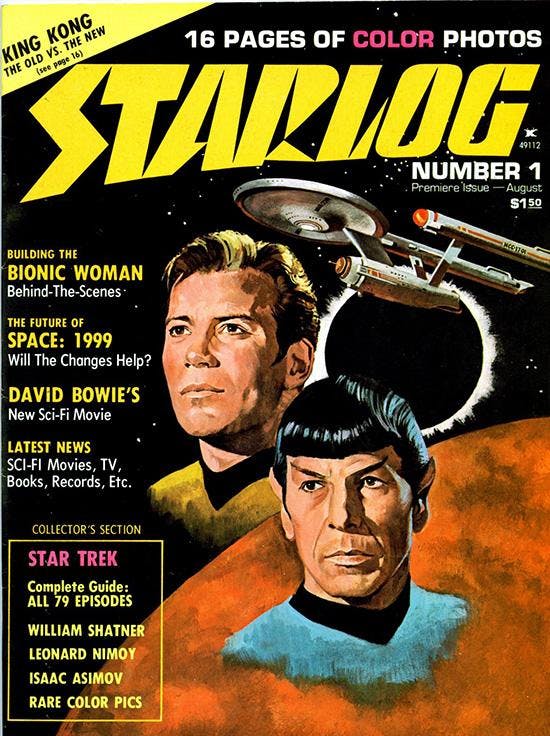
Veteran Mad Magazine artist Jack Rickard painted issue #1’s cover—a two-shot of Kirk and Spock (what, no McCoy?)—in an extremely straight style at odds with Rickard’s (ab)normal, wacky Mad Magazine manner. You can get a taste of his Mad-ness in the Trek-celebs-at-a-con cover he did for Starlog #3. Issue #1: noble, serious heroism. #3: lighthearted, all-out fun. Or more, succinctly, two Jekylls, then lotsa Hydes, all by Rickard.

Following the Famous Monsters of Filmland tradition (the publication’s forerunner in the 1960s, which covered horror movies), Starlog’s early issues boasted covers painted especially for the magazine by Rickard and others. Several issues showcased existing "space art," realistic astronomy-based paintings by Ron Miller and the fabled Chesley Bonestell (famed for creating the movie matte paintings for Destination Moon’s lunarscapes and Citizen Kane’s Xanadu mansion and other backgrounds). But soon, the publishers decided to only do photographic covers. Why? Readers seemed to like them better (do more of what sells!). And they were certainly easier, less time-consuming and cheaper to do. Arty covers became the exception, not the rule. I was named Editor in 1985 (and all covers discussed here—except for #1 and #3—were on my watch). However, I only got to do a handful of Starlog covers graced with movie poster key imagery or film/TV designs; I never commissioned art.
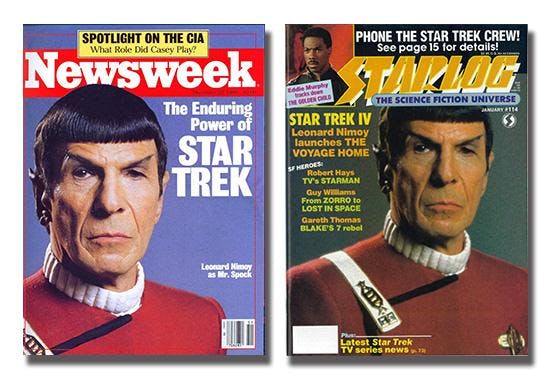
Look, there’s Leonard Nimoy. He’s on Starlog #114’s cover, out the first week of December 1986 for the premiere of Star Trek IV: The Voyage Home (which he directed). That wasn’t unusual. Nimoy appeared many times on Starlog covers (usually with a co-star or two). But here’s why we’re picturing it here: That same Spock image simultaneously graced the cover of Newsweek (then the second most important American magazine after its older rival Time).
Starlog probably got the photo first (non-exclusively, meaning it would also be "serviced," i.e. sent, to other media outlets) because our cover had to go to the printer far earlier, shortly after Halloween. Due to its 52-issues-a-year schedule, Newsweek didn’t really need the shot in hand until mere days before publication of its Dec. 22-cover-dated issue. Subscribers and newsstands had printed Newsweek magazines a week earlier, circa December 15, still well after Starlog #114, on sale Dec. 2 (the movie debuted Nov. 26). So, Newsweek staffers might have known of Starlog’s prior cover use of that shot. Starlog worked from a duplicate of the original photo—a slide the size of two postage stamps—whereas Paramount Pictures publicity almost certainly provided Newsweek (a more prestigious outlet) with the actual original image, a larger transparency. Newsweek also utilized pricier separator technology. You can see the differences between the two Spocks for yourself—and also note the variance in photo cropping (i.e. framing) and background shade. No doubt about it. Newsweek did it better.
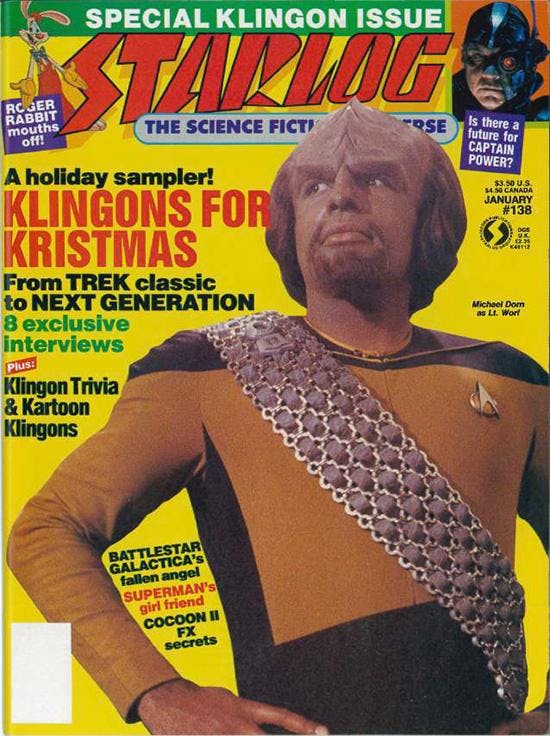
Two years later, there’s Starlog #138. In this case, there was no movie (Trek IV) or TV show premiere (Enterprise, #291) to tie in to, no big interview to be showcased (#130) and no default-to-Trek substitute covers (#162, #135, #147). This is a "concept cover," some intriguing idea brainstormed for the magazine’s exterior and only afterwards are its contents found (i.e. jerry-rigged by editors) to support that imaginative cover notion. Issue #138 would be on sale December 1988, so why not "Klingons for Kristmas"?
Out in Los Angeles, Starlog writer Kathryn M. Drennan (then married to Babylon 5 creator J. Michael Straczynski) was just about to do another Michael Dorn interview (the third or fourth of a dozen overall I edited, including one by me). Across town in LA, Bill Warren was transcribing a chat with Conrad John Schuck of McMillan & Wife. Up in Toronto, Peter Bloch-Hansen had the assignment to talk to noted Canadian thespian John Colicos, Baltar of the original Battlestar Galactica. Meanwhile in Boston, Will Murray had quizzed Night Court’s John Larroquette that summer on the set of Second Sight, an obscure fantasy comedy shot there on location. Why not run those four stories all in one issue? Plus, we could add mini-interviews with my pals William Campbell (by Steven H. Wilson) and Mark Lenard (by me) as well as Michael Ansara and Tige Andrews (both by Mark Phillips). Talk about Klingons for Kristmas! You’d get Worf, the Klingon Ambassador, Kor, Maltz, Koloth, the Klingon Captain, Kang and Kras. Eight Krazy Klingons all in one issue! What a Kolossal Koncept!
The publishers liked the idea, so after surviving the coverline and cover meetings, I gave the final words and pictures (slides) to Starlog Art Director (later Creative Director) W.R. "Bill" Mohalley. A veteran of Warren Publications’ Famous Monsters of Filmland, Creepy, Eerie and Vampirella, Mohalley joined the company six months after me, with issue #71 in 1983. He designed all the Starlog covers pictured (except, of course, #1 and #3) and indeed all of the magazine’s covers until its end (with #375). Now, bells ringing, he went to (Kristmas)town! He gave #138 a red-green-yellow, festive look, though it isn’t holiday-kitschy—festooned with holly, ribbons and wreaths—as I once imagined it. A bonus present for me, there were no letters to the Editor complaining about our spelling Christmas with a "K."
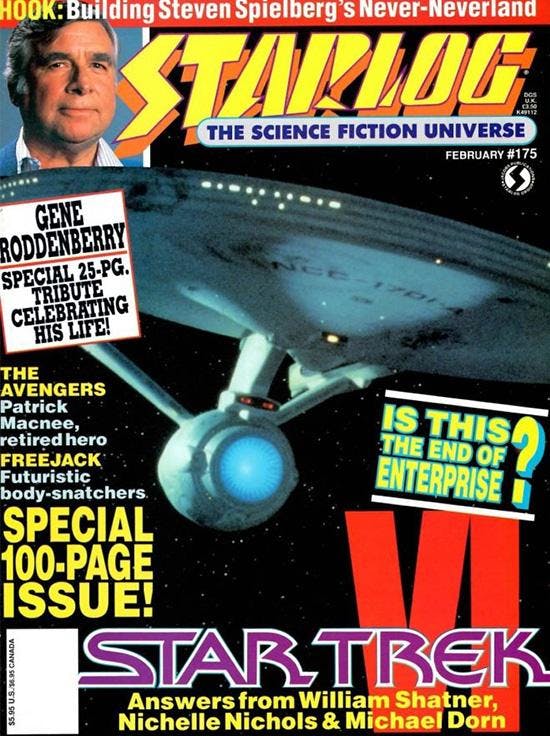
Star Trek creator Gene Roddenberry died October 24, 1991, just as we were finishing Starlog #174. We were able to sneak in a brief notice of his death when that issue went to the printer days later, promising more next time. But that didn’t turn out as planned. Issue #175 included extra pages (at added price) and a special section saluting Roddenberry with appreciations written by George Takei, A.C. Crispin, Peter David, Howard Weinstein, J.M. Dillard, Robert Greenberger, Diane Carey, Brad Ferguson and former Starlog Publisher O’Quinn. There’s a long obituary by Lee Goldberg as well as continued coverage of the just-released Star Trek VI: The Undiscovered Country.
What it didn’t have (as you can plainly see) is a full-cover shot of our beloved Great Bird of the Galaxy, Roddenberry; it’s the Starship Enterprise instead. I had hoped to make Gene’s photo (used there in the corner) the main cover shot, but Publisher Jacobs flatly vetoed that idea. He didn’t think that (real) death would sell and, besides, due to the timing of events, our potential obituary cover would be out in January, 1992, some 10 weeks after Roddenberry’s death, making it not only yesterday’s news but last year’s, too. I disagreed then (and now), but I couldn’t dissuade Jacobs otherwise. He could always overrule anyone. He owned the company. I still regret that cover decision, though. Sorry, everyone.
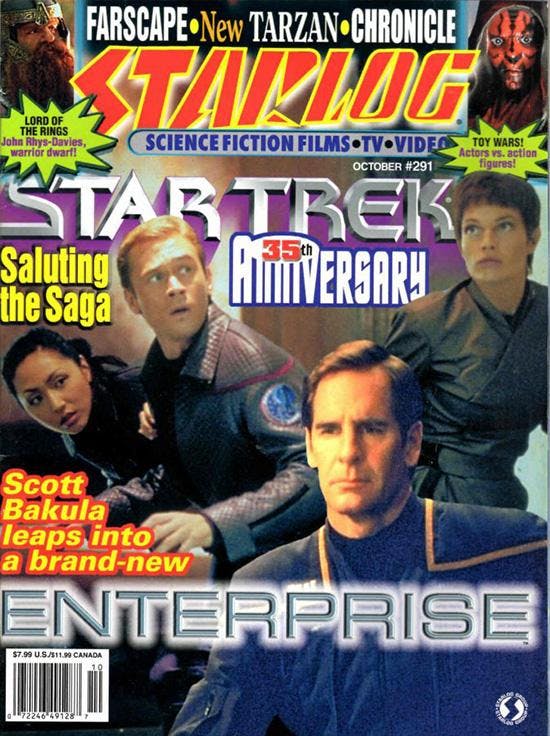
Finally, here’s another regret, one of our lousiest looking covers of all time—and certainly our worst looking Trek Starlog cover ever. Issue #291 (cover-dated October 2001, picturing Scott Bakula and three Enterprise co-stars) went on sale circa September 4 (days before the tragedy of 9/11). This meant it was due at the printer the first week of August. And here’s the problem: UPN (the network launching this new Trek TV show that fall) did not then have a large number of Enterprise images available to the media—eight, maybe 10 in all. I talked to UPN publicists until I was Andorian blue in the face, but I couldn’t persuade them we required more (and better) images. This was it, for now. Nein. Nada. No mas.
We did consider refusing to play this entertainment publicist game and to simply not give Enterprise a cover—which would have been interpreted in some quarters as a naked, cold-blooded insult to the new show. As much as I didn’t want to use a crappy, too dark shot on the cover, that image was our only option. Jacobs concurred. In retrospect, citing aesthetics and publicist intransigence, we should have just deep-sixed that Enterprise cover in favor of something else, anything else. And then endured the wave of seething indignation for allegedly insulting Enterprise just as it premiered. Sigh.
That’s enough Strange Starlog Cover Stories for today. I’ve got a few more to tell. Another time.
____________
David McDonnell, "the maitre’d of the science fiction universe," has dished up coverage of pop culture for more than three decades. Beginning his professional career in 1975 with the weekly "Media Report" news column in The Comic Buyers’ Guide, he joined Jim Steranko’s Mediascene Prevue in 1980. After 31 months as Starlog’s Managing Editor (beginning in October 1982), he became that pioneering SF magazine’s longtime Editor (1985-2009). He also served as Editor of its sister publications Comics Scene, Fangoria and Fantasy Worlds. At the same time, he edited numerous licensed movie one-shots (Star Trek and James Bond films, Aliens, Willow, etc.) and three ongoing official magazine series devoted to Trek TV sagas (The Next Generation, Deep Space Nine, Voyager). He apparently still holds this galaxy’s record for editing more magazine pieces about Star Trek in total than any other individual, human or alien.
Copyright 2014 David McDonnell

